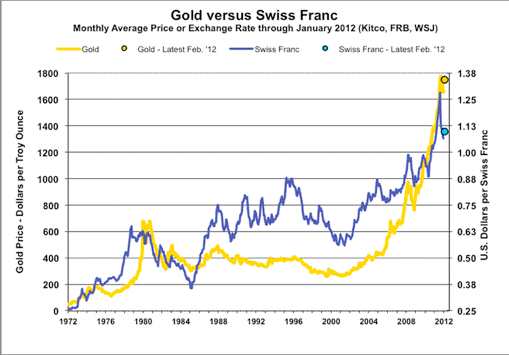Home › 6a) Gold & Monetary Metals › 6a.) GoldCore › Quantitative Easing: A Boon or Curse?
Permanent link to this article: https://snbchf.com/2021/07/flood-quantitative-easing-boon-curse/
Receive a Daily Mail from this Blog
Live Currency Cross Rates
 On Swiss National Bank
On Swiss National Bank
-
SNB Sight Deposits: increased by 1.7 billion francs compared to the previous week
2 days ago -
2025-07-31 – Interim results of the Swiss National Bank as at 30 June 2025
2025-07-31 -
SNB Brings Back Zero Percent Interest Rates
2025-06-26 -
Hold-up sur l’eau potable (2/2) : la supercherie de « l’hydrogène vert ». Par Vincent Held
2025-06-24 -
2025-06-25 – Quarterly Bulletin 2/2025
2025-06-25
 Main SNB Background Info
Main SNB Background Info
-
SNB Sight Deposits: increased by 1.7 billion francs compared to the previous week
2 days ago -
The Secret History Of The Banking Crisis
2017-08-14 -
SNB Balance Sheet Now Over 100 percent GDP
2016-08-29 -
The relationship between CHF and gold
2016-07-23 -
CHF Price Movements: Correlations between CHF and the German Economy
2016-07-22
Featured and recent
-
 Schweiz – Auswanderungsland für Deutsche? Erfahrungen, Volksabstimmungen, Russland, EU und NATO
Schweiz – Auswanderungsland für Deutsche? Erfahrungen, Volksabstimmungen, Russland, EU und NATO -
 American Silver Eagle: The Best Investment In Precious Metals Silver Coins
American Silver Eagle: The Best Investment In Precious Metals Silver Coins -
 Nebenkostenabrechnung muss bis Ende Dezember kommen 🧾
Nebenkostenabrechnung muss bis Ende Dezember kommen 🧾 -
 BASF setzt Frist, Bayer plant Umsatzverdoppelung, Ford zieht die Reißleine
BASF setzt Frist, Bayer plant Umsatzverdoppelung, Ford zieht die Reißleine -
 Nestlé allowed to continue French Perrier operations
Nestlé allowed to continue French Perrier operations -
 Truth or tale: Would inheritance taxes trigger a mass exodus of millionaires from Switzerland?
Truth or tale: Would inheritance taxes trigger a mass exodus of millionaires from Switzerland? -
 BLue Owl Roils The AI Narrative
BLue Owl Roils The AI Narrative -
 What Inflation Alarmists Missed In Their Warnings
What Inflation Alarmists Missed In Their Warnings -
 EILT: Musk revolutioniert Welt mit dieser Erfindung?!
EILT: Musk revolutioniert Welt mit dieser Erfindung?! -
 Reduced US tariffs ‘remain a burden’ for Swiss economy
Reduced US tariffs ‘remain a burden’ for Swiss economy
More from this category
 Nestlé allowed to continue French Perrier operations
Nestlé allowed to continue French Perrier operations19 Dec 2025
 Truth or tale: Would inheritance taxes trigger a mass exodus of millionaires from Switzerland?
Truth or tale: Would inheritance taxes trigger a mass exodus of millionaires from Switzerland? 19 Dec 2025
 BLue Owl Roils The AI Narrative
BLue Owl Roils The AI Narrative19 Dec 2025
 What Inflation Alarmists Missed In Their Warnings
What Inflation Alarmists Missed In Their Warnings19 Dec 2025
 Reduced US tariffs ‘remain a burden’ for Swiss economy
Reduced US tariffs ‘remain a burden’ for Swiss economy19 Dec 2025
 Switzerland considers AI data ‘theft’ defence
Switzerland considers AI data ‘theft’ defence19 Dec 2025
 Record number of guests in 2025: Swiss tourism boss
Record number of guests in 2025: Swiss tourism boss19 Dec 2025
- Party Over Principle: A Lesson from the Bloody Shirt Era
19 Dec 2025
- Inflation and the Intergenerational Housing Rivalry
18 Dec 2025
 UBS plans January job cuts: media report
UBS plans January job cuts: media report18 Dec 2025
- QJAE: Ulysses S. Grant and the Panic of 1873
18 Dec 2025
- November’s Weak Jobs Report Pushes the Fed Toward More Monetary Stimulus
18 Dec 2025
- JLS: What Is The Libertarian Theory of Parental Obligations?
18 Dec 2025
 Zurich fears impact of rumoured UBS move
Zurich fears impact of rumoured UBS move18 Dec 2025
- We Cannot Build an Economy on Lies
18 Dec 2025
- The Evil of the Welfare State
18 Dec 2025
- CPI Price Inflation Slows as Oil Prices Fall and Rents Flatten
18 Dec 2025
- The Death of DOGE and the Triumph of the Establishment: A Review of 2025
18 Dec 2025
 US ‘strikes price cut deal’ with Swiss pharma giants
US ‘strikes price cut deal’ with Swiss pharma giants18 Dec 2025
- Why William F. Buckley Pushed the John Birchers from the Conservative Movement
18 Dec 2025











Quantitative Easing: A Boon or Curse?
Published on July 24, 2021
Stephen Flood
My articles My videosMy books
Follow on:
Central banks’ massive Quantitative Easing (QE) programs have come under scrutiny many times since the central banks fired up the printing press and began quantitative easing programs en masse after the 2008-09 Great Financial Crisis.
However, the increase in central bank assets due to quantitative easing programs during the crisis pale in comparison to the QE programs during the Covid pandemic.
As economies recovered after the Great Financial Crisis many worried that consumer price inflation would rise rapidly due to the extra liquidity in the market. A fear that never materialized as many economies stayed well below central bank inflation targets.
Quantitative Easing Leading to Financial Crisis?
The question being asked now is have these programs led to financial mania?
This is how Peter Fisher, former executive vice president and manager of the System Open Market Account of the New York Federal Reserve, describes the effect of the action of the Fed in the PBS Frontline (U.S. based) program released on July 13. Mr. Fisher goes on to say that when he
The Frontline program does also have interviews with supporters of QE; “we’re lucky that the government was successful, or we could be living through a true depression”, stated Lev Menand, a former economic advisor to the Fed and the Treasury Department.
But the overall message of the program is that, “while well-intentioned, the Fed’s experiment has delivered mixed results over the years, some experts say in the documentary, with the biggest benefits going to Wall Street rather than Main Street, wealth inequity widening and the risk of inflation growing — over the past year, in particular. In addition, the Fed has insisted signs of inflation are temporary. However, has signaled it may taper quantitative easing and raise interest rates as early as 2023.”
Moreover, even investors that have greatly benefited from the Fed’s program. Such as Jeremy Grantham, spoke out against the unintended consequences of the massive QE programs;
Quantitative Easing Causing More Harm Than Cure?
Mr. Fisher describes QE as “pretty basic in medicine that our doctor may give us a drug, which, in a small punchy dose, for a brief period of time, might help us recover from whatever ails us … But that the same medicine, the same drug, taken in massive doses over long periods of time, might kill us or make us ill or have perverse side effects.”
…. Or the medicine intended to cure, or lessen the pain, could become an addiction. This is exactly what a report published on July 16th from the House of Lords, Economic Affairs Committee titled: Quantitative Easing: a Dangerous Addiction?
According to a Bloomberg article, penned by Mervyn King, a member of the committee which issued the report, the answer to this pointed question as the title is “Yes”. Mr. King goes on to say that the report has four important points.
The first point of the report is for central banks to not get locked in the mindset that all the rise in inflation is transitory. Although he agrees that some components will be due to base effects he warns central banks that “the lack of concern that has characterized central-bank statements — at least until the last few days — fuels the perception that policy makers are stuck with their “lower for longer” mindset. This matters, because if policy falls behind the curve, the cost of tackling a rise in inflation will be higher than it would be under a forward-looking, preemptive approach.”
The second point of the report is that: “QE is not a cure-all. QE has become a universal remedy for almost any macroeconomic setback. But only certain shocks merit a monetary-policy response. Moreover, the explanations provided by central banks to justify the scale of QE in 2020 changed over the course of the year. It failed to distinguish between shocks that justified a monetary response and those that didn’t.”
The third point of the report is that: “QE poses risks for central-bank independence. QE has made it easier for governments to finance exceptionally large budget deficits in the extraordinary circumstances of Covid-19. But when the central banks reduce this support, will they come under pressure to help finance ongoing budget deficits or to keep short-term interest rates close to zero? It’s possible they will.”
And the fourth point of the report is that: Central banks need to have an exit plan. QE tends to be deployed in response to bad news, but isn’t reversed when the bad news ends. Mr. King goes on to say that
Full story here Are you the author?Follow on:
No related photos.
Tags: Business,central-banks,Commentary,Economics,economy,Featured,Federal Reserve,federal-reserve,Finance,Financial crisis,inflation,Interest rates,Monetary,Monetary Policy,money,News,newsletter,Quantitative Easing